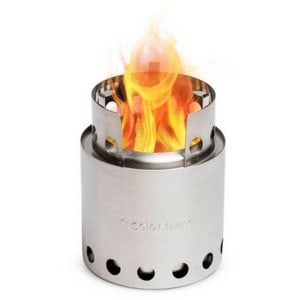Can You Safely Use a Propane Camping Stove Indoors?
Camping stoves are a fantastic way to cook food fast while exploring the great outdoors. Their portability and convenience make them a must-have item for campers and backpackers alike.
But what about when you’re stuck indoors during inclement weather, or want to have a hot meal when your gas stove is broken?
Can you use a camp stove indoors? The short answer is using a camping stove indoors should be a last resort if cooking outside isn’t possible.
Can you use a camping stove inside a tent? No. Using any kind of stove inside a tent is never a good idea.
Potential Risks of Using Camping Stoves Indoors
Using a propane camping stove may seem like a convenient way to cook inside when your home kitchen isn’t available, but it comes with some serious risks.
Fire Hazards: When using a propane stove indoors, the chance of starting a fire increases significantly.

Make sure to keep a safe distance between the open flame and flammable items. Never leave the stove unattended while burning.
Carbon Monoxide (CO) Poisoning: CO is a toxic gas produced by burning fuel in an enclosed space. It is colorless, odorless, and tasteless, making it difficult to detect.

Exposure to high levels of CO can cause dizziness, headaches, and even death. You should always use a CO detector when using a propane stove indoors.
Oxygen Depletion: Burning fuel requires oxygen, and in a small space, a camping stove can quickly consume the available oxygen, causing dizziness or fainting.
Gas Leaks: Some camp stoves use propane or other pressurized fuels which can leak if not properly connected or maintained.

A gas leak in an enclosed space can be extremely dangerous and result in an explosion or fire. Always double-check connections.
While a camping stove might seem like a good option in emergency situations, the associated risks make it a dangerous option.
Understanding Camping Stoves
When planning a camping trip, it’s important to consider the right type of camping stove for your needs. There are various types of camping stoves available, each with its unique characteristics and fuel requirements.
Propane Stoves
Propane Stoves are the most common camping stoves due to their ease of use and availability. Because they use replaceable propane canisters, propane stoves are convenient for short trips.
Isobutane-Propane
Isobutane-Propane Stoves are a blend of isobutane and propane fuels. These backpacking stoves provide consistent performance in various weather conditions and altitudes.
Jetboil stoves are a common choice for backpackers.
Alcohol Stoves
Alcohol Stoves are another lightweight and cost-effective option. They burn denatured alcohol, which is a relatively safe and clean fuel.
These stoves are simple in design, usually featuring a burner and a container to hold the alcohol.
Butane Stoves
Butane Stoves work similarly to propane stoves but use butane as their fuel source. They’re compact and lightweight, making them ideal for backpacking trips.
However, butane canisters can be harder to find compared to propane canisters, and butane may not perform as well in cold temperatures.
Wood Burning Stoves
Wood-burning Stoves allow you to use the natural resources around you as fuel. They’re eco-friendly and perfect for those who prefer a more traditional camping experience.
However, they can be less efficient and can produce more smoke than other types of stoves.
Kerosene Stoves
Kerosene Stoves are an older option but still relevant for some campers. They burn kerosene, which is a liquid fuel similar to gasoline.
This type of stove may require more maintenance, and the fuel has a strong odor.
White Gas Stoves
White Gas Stoves use white gas, or naphtha, which is a highly-refined fuel.
They can be more difficult to use than other stoves, but they’re generally more fuel-efficient.
As you explore your options, remember to consider factors like fuel availability, ease of use, and how well the stove performs in the conditions you expect to encounter during your camping trip.
Safety Precautions
If you are going to use a camp stove indoors, you need to use common sense to avoid accidents. Here are some safety tips:
- Ventilation: Only use a camping stove in an area with good ventilation.
- Level Surface: Cook on level surface to minimize the risk of your stove tipping over.
- Fire Extinguisher: Always have a fire extinguisher nearby and be familiar with how to use it in case of an emergency.
- Flame Control: Adjust the flame to the lowest level needed for cooking and never leave it unattended.
- Safe Use: Follow the manufacturer’s guidelines for the safe use of your camping stove.
Importance of Ventilation
This cannot be stressed enough. When using any kind of gas camp stove indoors, you need to make sure you have enough ventilation.

Opening windows is a simple yet highly effective way of promoting consistent ventilation. This allows fresh air to flow in and disperse any harmful gases.
Camping stoves often produce a significant amount of heat. To reduce the fire risk, keep your stove at least 1 foot away from the walls and other flammable materials.
Carbon Monoxide Issues
It’s essential to be aware of the dangers posed by carbon monoxide (CO).
Carbon monoxide is a colorless, odorless, and tasteless gas that can cause serious health problems and even death.
Make sure your indoor space is well-ventilated. Open windows and doors nearby to allow for fresh air to circulate, reducing the concentration of carbon monoxide in the room.
Additionally, avoid using a camping stove in small, enclosed spaces, as CO levels can rise quickly.
It’s also smart to invest in a carbon monoxide detector. These detectors will alert you if carbon monoxide levels become dangerously high.
Be aware of the symptoms of carbon monoxide poisoning, which include:
- Nausea
- Headaches
- Dizziness
- Shortness of breath
- Confusion
If you or anyone around you experiences these symptoms while using a camping stove indoors, turn off the stove immediately, open windows and doors to let in fresh air, and seek medical help.
Step-By-Step Guide to Using Camping Stoves Indoors
It’s essential to be cautious when using a camping stove indoors. Here is a friendly step-by-step guide to help you do it safely.
- Choose the right location: Find a well-ventilated area inside your home or in your RV or pop-up camper. Ensure the stove is stable and on a heat-resistant surface away from flammable materials.
- Check for leaks: Before lighting your camp stove, inspect the fuel canister, hose, and connections for any signs of damage or leaks.
- Ventilation is key: Always open windows or vents for proper air circulation to avoid carbon monoxide buildup.
- Light the stove safely: Keep your face and hands away from the burner when igniting it.
- Monitor the stove while in use: Never leave the stove unattended while cooking.
- Turn it off: After you’re done cooking, turn off the stove and let it cool down completely before handling or storing it.
It’s especially important to use extra caution when in bear country, as the smell of cooking can attract unwanted visitors. We never cooked inside my parent’s pop-up camper when I was younger.
Frequently Asked Questions

I’m Molly Foss, aka Momma Critter. I’ve been camping since I was 9 years old and I always wanted to be Robin Hood and live in the forest when I grew up. I’m excited to share my love of camping with my son as he grows up. My favorite thing to do while camping is roast marshmallows over the fire.













